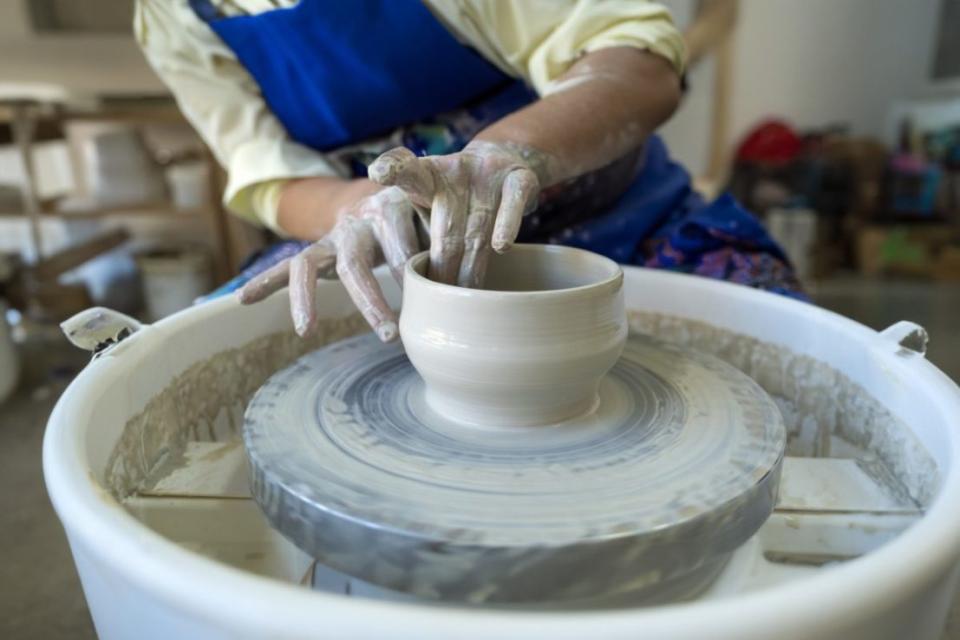Build, Baby, Build: Move over avo toast, ceramics are Gen Z’s housing crisis crutch

Gen Z and Millennials are spending more time and money on interior design, not despite, but because of, the housing crisis, writes Anna Moloney
If you have recently walked down Columbia Road on a Sunday morning, you will have found yourself in yuppie wonderland, weaving your way between hordes of 20-something-flat-white-clutching Gen Zers, looking for a new houseplant to add to their no doubt already large collection.
Yet it’s not just East London hipsters, with houseplant sales nationally having more than doubled since 2019, according to Tesco. Bury Lane, a supplier for the supermarket, now produces half a million plants a year to keep up with demand and has cited an increased buzz from younger people, who are “interested in building their own indoor gardens”.
But why? Well, it’s not simply a greenfingered hysteria, with Gen Z’s horticultural enthusiasm just one aspect of their increased interest in everything to do with home interiors. From ambience-setting candles to Instagrammable bookshelves, Gen Z and Millennials are more willing to spend time and money on improving the look of their homes, as they expand the importance of their “aesthetic” to also include their home space – this all not just despite, but arguably because of, their own struggles to get on the housing ladder.
A report from buy now, pay later firm Clearpay, for example, showed home and recreation spending was the fastest-growing category for spend among Gen Z and Millennials, growing above 300 per cent year-on-year in 2021. Rather than big-ticket items like furniture, the rise has been driven by soft furnishings, with cushions and cacti not only within younger consumers’ budgets, but also easy to cart from house share to house share. In this way, they mark a modern iteration of the “lipstick effect”, representing a small but achievable indulgence for cash-strapped Gen Zers.
Fashion retailers have been quick to capitalise on the trend. Asos launched its own homeware brand in 2018, while homeware-fashion hybrid brands like Oliver Bonas, Urban Outfitters and French Connection have also ramped up their home decor offerings with a distinct consumer in mind: Generation Rent.
“We’re in a time when people are unable to move to a new house easily and so to make up for this, the customer is refreshing their interiors more regularly. We have a high number of customers in urban areas, lots of whom are likely to be part of Generation Rent. This younger customer is keen to purchase standout rugs, chairs and lighting to personalise and define their rental space,” a representative from French Connection told Drapers in 2021.
Then-head of marketing at Oliver Bonas Gina Coladangelo noted a similar trend, saying the brand was seeing “younger shoppers thinking about homeware earlier”, with those in shared living spaces still wanting their spaces to look picture-ready thanks to the influence of Instagram and other social media sites. Since then, the scope of home influencers has only grown, with renter-friendly home upgrades (from peel and stick wallpaper to battery-operated wall sconces) now a mainstay of the genre.
Ikea’s expansion into urban centres – notably its upcoming opening on Oxford Street – is a savvy move within this context, with the stores’ low price point, along with its focus on items that can be brought home on the Tube, likely to appeal to London’s young renters.
But the trend goes beyond consumption. Increasingly, aesthetics have become a way for young people to express and define themselves in a world where the normal markers of achievement – most notably home ownership – become further out of reach. In this way, focusing on the “aesthetic” of one’s living space offers young people a way to claim their own sort of ownership over their home – even if superficial.
At the same time, curating one’s own home space allows for a sense of pride, with the idea of personal achievement increasingly evident in home trends. The Ikea effect, which describes a cognitive bias in which people place a disproportionately high value on things they themselves have partially created, goes some way to explaining not only the continued success of Ikea, but also the recent explosion in crafting workshops. Arguably, no trendy London area is now complete without its own ceramics studio or paint and sip workshop.
Edouard Eyglunent, co-founder of Wecandoo, a company that offers artisan workshops from pottery to silversmithing throughout London and Europe, said Gen Zs and Millennials made up 75 per cent of its customers. Social media was partly the motivator – rug-tufting bookings have jumped 200 per cent over the last year thanks to Tiktok – but Eyglunent explained it was also about personalisation and self-expression: “It’s an opportunity to truly connect with something tangible to create your own unique masterpieces.”
All in all, whether it’s marathon-running or pottery-throwing, Gen Z and Millennials are looking for markers of achievement (and that sweet dopamine hit) wherever they can. And until we build more houses to give them the chance of actually owning a roof over their head, rather than just a few cushions and a couple of Swiss cheese plants, this trend isn’t going anywhere. So next time you want to scoff at those avocado brunches, widen your scope, and tut at their houseplants too.

 Yahoo Finance
Yahoo Finance 